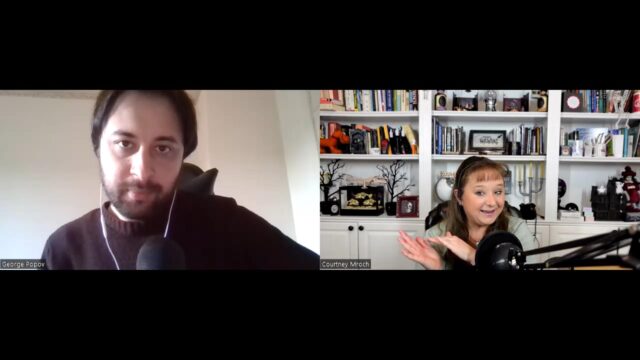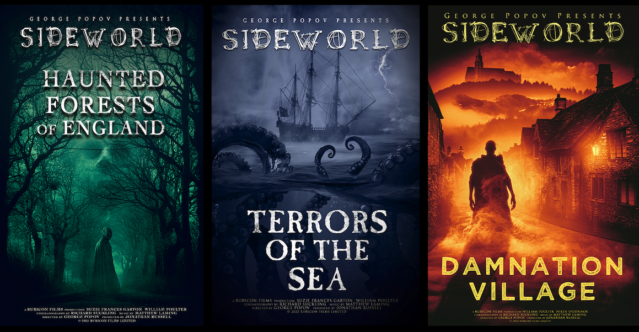
At the start of each Sideworld documentary, George Popov delivers a monologue reminiscent of Rod Serling’s Twilight Zone introduction. It goes like this: “When the line between fact and fiction is enshrouded in mist and shadow, beyond that threshold is a place that can change our perspective on everything we think we know. I call this place the Sideworld.”
In a previous post, I talked about the three Sideworld documentaries that Rubicon Films has out so far. They include Haunted Forests of England, Terrors of the Sea, and Damnation Village, all of which are narrated by George Popov.
They’re all available to rent or buy on Amazon in both the UK and the US. If you don’t mind commercials, you can also watch them on Tubi.
Ahead of my interview with George, I watched Damnation Village to get a taste of what Sideworld is all about. As I wrote in the post about the films, their mission is “to bring lesser-known paranormal encounters and forgotten folklore to light with style and substance, breathing new life into the genre.”
Damnation Village covered three villages, including Pluckley, Prestbury, and Eyam. I was familiar with Pluckley since I’d hunted down a copy of the 1989 Guinness World Records book to see if it really listed it as England’s Most Haunted Village. Which it did, but that led to another mystery since that was the only time it received that designation.
I reached out to Guinness to find out why. Did it have to do with a couple of clauses that explained its stringent criteria for setting records? Yep. To my delight, Guinness wrote back explaining that “most haunted” wasn’t “measurable, verifiable or standardisble,” which violated its criteria for granting a Guinness World Records title.
Still, because of Pluckley’s history, rumors of paranormal activity persist. I was excited to explore it via Damnation Village. And to ask George about it. But that’s not all we discussed.
Here are a few highlights from our chat, the entirety of which is embedded below.
How did Sideworld come about?

George explained Rubicon Films, the umbrella Sideworld falls under, also creates narrative feature films. It was while making Hex, a historical horror, and The Droving, a mystery thriller, that George and his teammate Jonathan Russell, concocted the idea for Sideworld.
As much as they’d like to make a horror or thriller movie inspired by every single incident they came across, there’d never be enough time to make them all. But they could still cover them in a documentary format and consolidate them into groups or themes.
My Favorite George Popov Quotes
George was explaining how they want to create a community for Sideworld that brings together those who love the paranormal, folklore, history, or just horror stories in general. That’s when he said:
“Because all of these things blend so naturally within each other, you can’t really talk about one without looking from the other side… If you want to explore the paranormal angle, you have to have at least a passing interest of where the boundary of where science ends and then fiction begins.”
I thought that was a brilliant way to put it!
But I also liked what he had to say about how he tries his hardest to be rational and what his viewpoint is:
“If I’m trying to tackle Sideworld as a place where the line between fact and fiction is very blurry, and we’re looking into that, then at least I have to know the difference between fact and fiction where that line is not.”
He then went on to add:
“Trying to be both a believer and a skeptic where it makes sense. And then everything in the middle I want to be open-minded for.”
Isn’t that marvelous? I totally related to that assessment. I feel it mirrors my own approach, but I’d never be able to express it so succinctly.
The Plague Village of Eyam
Eyam was the third and final village explored in Damnation Village. It definitely felt more poignant considering the pandemic we’ve all just lived through ourselves. Which, thankfully, was not as deadly as the Bubonic Plague that ravaged Eyam in 1665.
For any listeners, George saved me by giving some background on Eyam. (I started rambling on like everyone who might watch our chat had already seen Damnation Village or was at least acquainted with Eyam’s story. Which I wasn’t until watching Damnation Village.)
Anyway, he explained how people heard what was happening in London but felt they were safe from the plague in Eyam…until it found its way to them. The villagers made the hard decision to quarantine themselves with no encouragement from anyone else. Their decision saved the surrounding areas but condemned a majority of their residents to death. And a very gruesome, painful one too.
As Historic UK explained, Eyam’s sacrifice ended up becoming “a case study in the prevention of disease.” And it was truly a sacrifice. In some cases, entire families were wiped out.
Damnation Village shared the same quote from historian William Wood that Historic UK included in their article, which is a beautiful tribute to the villagers of Eyam:
“Let all who tread the green fields of Eyam remember, with feelings of awe and veneration, that beneath their feet repose the ashes of those moral heroes, who with a sublime, heroic and unparalleled resolution gave up their lives, yea doomed themselves to pestilential death to save the surrounding country. Their self sacrifice is unequalled in the annals of the world.”
The quote was impactful enough, but what made it even more so was when the names of all of the nearly 300 residents who died because of this extraordinary sacrifice scrolled afterward.
Eyam Among Favorite Filming Locations
George said he didn’t really have any favorite places they filmed. He liked them all! However, he did note Eyam was one of the more memorable. He and the rest of the crew very much felt the weight of all the plague graves. The museum houses also are a constant reminder of the dark history.
However, the residents add the charm. He said they were welcoming and had an unexpected dark sense of humor. And they were very conscientious about the positivity that came from their village’s place in history, which the people of Eyam don’t shy away from. In fact, he said they embrace tourism without making it exploitative or tacky and cheap. Whether they’re related to people who lived in the village during the time of the quarantine or not, they focus on the good that came from the sacrifice.
Did they have any experiences while they were filming in all these creepy places?
Not really. Then again he admitted he’s so busy and focused on what he’s doing when he’s working that he probably wouldn’t notice. Or as he put it, “If I did, I wouldn’t have known because we were so busy trying to get the shot I would’ve been ‘Dude, can you move?'” (Meaning if a ghost had materialized in front of him.)
However, he did say there were a couple of places where weird things sort of caught his attention anyway, like when they went to Epping Foreast for Haunted Forests of England to cover the story of the Suicide Pond.
George explained in general the forest was creepy because it contains a lot of lakes and ponds. However, no one knows which one is really the fabled Suicide Pond. People say it’s evil and takes people to a dark place. It became like a whodunnit to try and find it, and they were filming as if any of them could’ve been it, but…
There was one in particular where he and Rich, the cameraman, both agreed it felt different. Almost bad. There was a palpable shift in the atmosphere around it and they felt like that pond might be the one.
But they’ll never know for sure.
Music Recorded in Haunted Places
I was complimenting George on how Damnation Village was shot. I mentioned a detail, a closeup of a keyhole that they’d included, and how I liked it because I have a thing for doors and stairs. It was a random comment that sparked a revelation I never would’ve thought to even ask about.
George explained they concentrated on details like that while filming to enhance the mood and atmosphere of their storytelling style. Which is narrative rather than investigative with eyewitness testimonies and expert talking head interviews.
But like all docs, they incorporate visuals to help tell the story. He explained it’s the attention to the small details that make a difference. Most people don’t even recognize that they aid in bringing the story to life or setting the mood. It reminded me an awful lot of some of the chats Eli Roth had with writers and directors at the end of some of the Urban Legend episodes. There’s a lot more planning and calculation that goes into filming than most people realize. (Or at least that I ever realized.)
That’s when he also mentioned the music. He gave shout-out to Matthew Leming in Ireland, and explained how he actually went to the haunted places to make the recordings and they used a lot of that. Leming even obtained actual recordings from the shipwrecks, which they used in Terrors of the Sea.
So it wasn’t just sights, but also sounds, they were conscious of incorporating into their Sideworld films to make people feel like they’re there. Which I think they accomplish. It’s a great way to travel vicariously without leaving the comfort —or safety— of home.
Watch the Interview with George Popov
For More Info
Visit https://www.rubiconfilms.co.uk.
Check-In
Did you know that Eyam was where the model for quarantining to stop the spread of infections began?
Courtney Mroch is a globe-trotting restless spirit who’s both possessed by wanderlust and the spirit of adventure, and obsessed with true crime, horror, the paranormal, and weird days. Perhaps it has something to do with her genes? She is related to occult royalty, after all. Marie Laveau, the famous Voodoo practitioner of New Orleans, is one of her ancestors. (Yes, really! As explained here.) That could also explain her infatuation with skeletons.
Speaking of mystical, to learn how Courtney channeled her battle with cancer to conjure up this site, check out HJ’s Origin Story.

I think the Plague put Eyam on the map!
What a great point, Priscilla! Yes, it sure did, didn’t it?